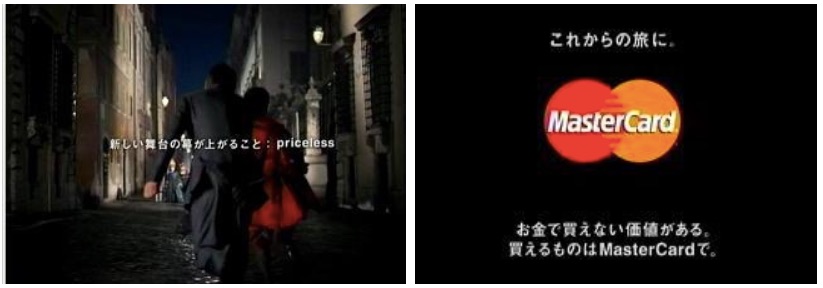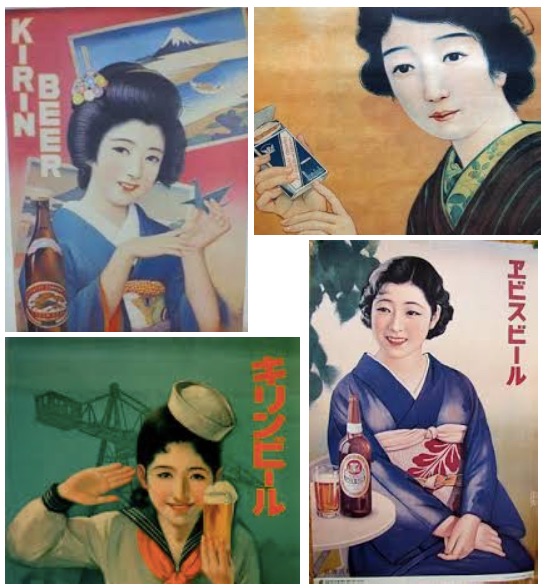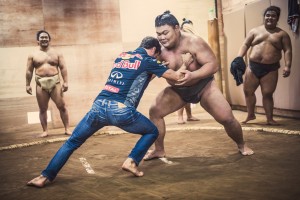I have seen this process from both sides, initially while working in the UK office of a big international agency, where we were the hub, creating and “distributing” campaigns to other markets. But ever since arriving in Japan I have mainly been “on the receiving end” as it were, and it is exacerbated by the fact that Japan really is a different market. Whether that difference is fundamental, or one of degrees, is a question I have explored in previous posts, such as this one describing the Japanese advertising industry, but for the purposes of this article I will focus mainly on the cultural and linguistic gap.
In fact, for many of the international agencies in Tokyo, most of the work they do is in-bound localisation, and if they are not empowered to properly adapt or transcreate the brand to Japan – which is often true – it can be quite an unrewarding role. It’s one of the reasons I actually got frustrated and struck out on my own from one of those big networks to start up my own agency here in Tokyo back in 2004.
Although 90% of the work we do at Profero Tokyo is original to Japan, from time to time we lead a localisation process, and when conducted in a strategic way, they never fail to reveal deep insights into the core brand DNA and highlight the fundamental similarities and differences between cultures, and hence can be fascinating and rewarding projects to be part of.
The Brand Localisation Framework
For simplicity I am going to look at localising brand taglines specifically, and use them as a proxy for brand positioning, because ultimately this is the point. I am going to use “tagline” to mean either the semi-permanent brand tagline motifs, as in “Honda – the power of dreams”, as well as product-brand taglines, and also campaign taglines, such as Apple’s “Mac vs PC”, which are obviously more transient, but essentially the process is the same.
In some of the examples, e.g. MasterCard, a campaign tagline ends up becoming the brand tagline, for a good few years at least, which is far from uncommon, so overall I feel confident generalising in this way.
It is also true that the same principles can be applied to other executional choices when localising e.g. the visual realm, choice of music, voice actor, you name it. All elements ultimately need to be considered within the same framework.
In general I think there are 3 approaches to bringing a global tagline into Japanese.
Approach 1: Leave it in English
- Although in many European markets and some Asian, proficiency in English is high enough to just go with a tagline originally crafted in English, that is not true of Japan, so unless it is really, really simple the target audience will not understand it.
- This can be justified if you can assume that some people will get it, and for the rest spell it out in some form or another: sometimes just writing it in katakana to make it feel more familiar, or else explain it in Japanese without attempting to replace the original English.
- This is often the most expedient approach for brands looking for global consistency more than local emotional connection.
- I believe it is usually a big missed opportunity and only really makes sense if the brand trades off its global status almost exclusively in differentiating itself.
- It is most likely to make sense for a brand that has lots of products that can have a product brand story told about them, and particularly if they are really innovative products.
- An example would be Nike’s “Just do it” motif. It really helps that the original is so simple that most of their target audience would get it, and the fact that their products are designed around universal human features, namely their bodies. However, it would be wrong to believe that Nike loses nothing by not having a proposition that is as powerful in Japanese as “Just do it” is in English.
- Another example would be the original iPod and iPod Nano TV campaign by Apple using the dancing silhouettes that became so iconic. If you have a break through product with visceral cut-through creative and your brand benefits from its foreign / global cache, then you can more or less leave it alone. These cases are fairly rare though.
Approach 2: “Adapting” it into the Japanese Culture
- The adaptation approach aims to bring the same meaning to life in Japanese as a copy line that stands on its own without any mention of the English mother line
- You usually create a variety of alternatives that range between being direct translations on one end of the spectrum, through to ones that take more license with the original meaning on the other, but might push a resonant button among the Japanese target (see option 3 below)
- The closer you are to the direct translation end, the more it feels to the audience like a direct translation, and this serves to emphasise the foreignness of the brand again.
- What usually happens in this scenario is you are able to hit on a copy line that more or less says what the original English line says, but it does not resonate as much as the original does in English, but the way a lot of brands think this is an acceptable price to pay for global consistency and feels like a safe choice
- The more license you take the more chance it has to resonate and feel like a made-for-Japan communication, but at the cost of consistency with the brand globally, causing unease for global brand managers
- Localising the tagline but then applying it to creative assets (such as TVCs, transit ad creative, web assets, etc) that have not been adapted or transcreated themselves leads to communications that do not quite add up to the local audience.
- If a brand has the local resources to develop local creative assets then I would usually be recommending the 3rd approach below, but these lines are blurry, and there are examples where this adaptation approach has been very successful.
- Foreign brands should not be trying to become or act like domestic Japanese brands, but rather to find a way to leverage their foreignness to give them an advantage over local competition (e.g. aspirational, innovative….), since the local players will usually always win on grounds of familiarity. Hence retaining an element of the global campaign is often a vital ingredient, not simply an acceptable compromise, and this would apply to Approach 3 below as well.
A priceless example
The Priceless tagline / proposition for MasterCard started off as a campaign but has more or less been woven into the fabric of the MasterCard brand as a permanent part of its identity. In general all credit card brands assert that when you pull out your credit card the brand name on it says something about who you are, and prestige often bordering ostentation is the traditional territory of the category. In contrast MasterCard’s agency developed this brilliant proposition:
“There are some things that money can’t buy. For everything else, there’s MasterCard”
The insight behind the campaign is that there are special moments in life, often serendipitous, usually shared with loved ones, that no amount of wealth could purchase. For a credit card brand (= access to money) to be dramatising this insight shows that the brand understands that there are more important things than itself. This implies that it is magnanimous, humble, and big-hearted, traits that many people would prefer to have associated with themselves. And besides the prestige can be communicated through the creative execution itself. It also taps into the post-80s/90s materialism sentiment that in fact luxury is at heart experiential, so it was and still is very much “of its time”. Copy lines never really work in isolation, and the high-end feel of the execution adds “luxury” attributes to MasterCard’s brand image.

“There are some things that money can’t buy. For everything else, there’s Mastercard” – Priceless Campaign localised to Japanese
The creative device evolved to become a very simple set up stating the price of an experience or thing, but then trumping it with an emotional outcome, which is “Priceless”. The simplicity of it is the hardest thing to adapt into Japanese, and actually this is always the case. The best copy lines or creative devices are sort of hacks of the language that manage to say something profound and impactful in a very simple way.
The only way to adapt this into Japanese AND retain the original meaning is to spell it out, but to find a copy line that does it in a relatively short and elegant way, and I believe they succeeded with “お金で買えない価値がある”, literally “there is value that cannot be bought with money”. MasterCard actually retain the English word “Priceless” as a branding device, more than because they assume their Japanese target would understand what it means. Many will not, but it becomes another branding device that adds value to the brand through repeated use.
Approach 3: Transcreation of the Concept into the Japanese Culture &Psyche
- This approach aims to take the DNA of the idea, and find a way of bringing that core idea to life within the Japanese psyche or culture in full knowledge that this will take it away from the original meaning.
- In terms of the creative development process it amounts to going back to the creative brief, rewriting that, effectively adapting that, and then starting afresh with the creative development working with Japanese planners and creatives.
- At that point what makes it the same campaign? Just how far can you strip a campaign back before it becomes something different? In fact, how far can you strip a brand back before it becomes something different?
- In its purest form the best creative briefs define the emotional response that you aim to elicit and empowers the creative process to press that button, which is always going to require language and culture-specific communications.
- Since the emotional responses of humans are universal, a creative brief stated in these terms and accurately translated into local languages can be the bedrock for a brand that plays in the same emotional territory wherever it is advertised in the world.
- To my mind this is the ideal approach since if a brand does not strike an emotional chord with people in a market, it will always be hobbled and less robust as a global brand because of it.
- However, the stimuli that will elicit the same desired emotional response will differ culture by culture, potentially target segment by segment too. This fact alone goes a long way to explaining why adapting brand strategies to multiple markets is such a tricky process.
- Usually you do not have or in fact are not able to strip a campaign concept to such bare essentials, for various reasons. For instance, the global client just does not have the bandwidth to get into the conceptual nuances in foreign markets. It is, after all, just one of many they have to manage. It is certainly true to say that the more they trust their local brand and agency teams, the more likely they are to allow the brand to be transcreated.
Semantic Ambiguity
One of the things you learn from working in the adaptation and transcreation areas a lot is that really good copy in any language leverages ambiguities implied by the choice of words to claim as broad an emotional relevance as possible while still “feeling” sharp and precise.
A good example that is close to my own heart is for the brand Indeed, the world’s biggest job search site, and adapting its global brand platform “How the World Works” into Japanese for its Japan market launch campaign, developed by our colleagues at MullenLowe in Boston.
The genius of this tag line in English is that it is a familiar expression that implies wisdom and knowledge of a complex human system, but by matching it to the context of recruitment sets up a double entendre with its literal meaning of how people find work, which is of course the raison d’être of the Indeed brand. The sharpest of communication strategists among you will have noted that this is an inherently flexible device since it says “we know how the world of employment works”, and, by inference, how to get you the right job, or to the companies recruiting the right candidates, but it does not say what that “How” is. The “how” comes in via the creative.
With the Japan launch of Indeed in 2015 the “How the World Works” campaign, which doubles as a brand tagline, was transcreated to carry a similarly powerful emotional evocation: 「その仕事が、世界を動かす」which back-translated says, “work that moves the world”. Brand positioning connoisseurs will have already noted that the savviness double-entendre is not retained in this transcreation, and instead emphasises what is more emotive connotation to Japanese people, the idea that your work has a higher purpose in the societal sense – a core brand value for the Indeed, although one that is not made explicit in its English tagline. If there is an intended ambiguity, it is in the way that 「世界」in Japanese can been both “your world” and “the World”, which was exactly the range of mental scales that we want the brand to transcend.
As someone who works across Japanese and English everyday, I am tempted to believe that the Japanese language, because of the unique way it has evolved as a sequence of assimilations of foreign languages, is extraordinarily flexible in the options it gives copywriters to play with, an unprovable theory that I intend to explore in a future post.
Approach 4: Stratified brand platforms
Is there a 4th approach? Actually, I think there is. It is where the international brand’s communications are stratified into global creative, usually in the approach 1 or 2 adaptation approach, usually projected through traditional media like TV. But then in other “high touch” channels like social, digital engagement and event-based promotions, the approach is closer to approach 3), being highly contextualised. This is often also very pragmatic given the centralised structure of many global brands, since seeing the same TV ads go out in all markets is very reassuring to those brand stakeholders who are not necessarily engaged in the nuances of international market cultures, but allows the freedom to the more ‘under the radar’.
A good example of this hybrid approach is RedBull, at least for the first few years after they launched in Japan, when they ran the global “Gives you wings” animated TV creative but simultaneously built out their extreme-sports & music-based engagement programs. It is my impression (I am not a RedBull expert) that now as a mature brand in Japan they have dropped the “gives you wings” TV work and have built out their extreme sports and music platforms into the dominant local brand-building platform, and very effective it is too.



Leave a comment